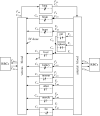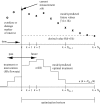Systems engineering medicine: engineering the inflammation response to infectious and traumatic challenges
- PMID: 20147315
- PMCID: PMC2880083
- DOI: 10.1098/rsif.2009.0517
Systems engineering medicine: engineering the inflammation response to infectious and traumatic challenges
Abstract
The complexity of the systemic inflammatory response and the lack of a treatment breakthrough in the treatment of pathogenic infection demand that advanced tools be brought to bear in the treatment of severe sepsis and trauma. Systems medicine, the translational science counterpart to basic science's systems biology, is the interface at which these tools may be constructed. Rapid initial strides in improving sepsis treatment are possible through the use of phenomenological modelling and optimization tools for process understanding and device design. Higher impact, and more generalizable, treatment designs are based on mechanistic understanding developed through the use of physiologically based models, characterization of population variability, and the use of control-theoretic systems engineering concepts. In this review we introduce acute inflammation and sepsis as an example of just one area that is currently underserved by the systems medicine community, and, therefore, an area in which contributions of all types can be made.
Figures









Similar articles
-
Translational systems biology: introduction of an engineering approach to the pathophysiology of the burn patient.J Burn Care Res. 2008 Mar-Apr;29(2):277-85. doi: 10.1097/BCR.0b013e31816677c8. J Burn Care Res. 2008. PMID: 18354282 Free PMC article. Review.
-
Translational systems biology of inflammation and healing.Wound Repair Regen. 2010 Jan-Feb;18(1):3-7. doi: 10.1111/j.1524-475X.2009.00566.x. Wound Repair Regen. 2010. PMID: 20082674 Free PMC article.
-
Translational systems biology of inflammation.PLoS Comput Biol. 2008 Apr 25;4(4):e1000014. doi: 10.1371/journal.pcbi.1000014. PLoS Comput Biol. 2008. PMID: 18437239 Free PMC article. Review.
-
Challenges and rewards on the road to translational systems biology in acute illness: four case reports from interdisciplinary teams.J Crit Care. 2007 Jun;22(2):169-75. doi: 10.1016/j.jcrc.2006.12.011. J Crit Care. 2007. PMID: 17548029 Free PMC article.
-
Hybrid semi-parametric mathematical systems: bridging the gap between systems biology and process engineering.J Biotechnol. 2007 Dec 1;132(4):418-25. doi: 10.1016/j.jbiotec.2007.08.020. Epub 2007 Aug 15. J Biotechnol. 2007. PMID: 17870200 Review.
Cited by
-
Computational Identification of Mechanistic Factors That Determine the Timing and Intensity of the Inflammatory Response.PLoS Comput Biol. 2015 Dec 3;11(12):e1004460. doi: 10.1371/journal.pcbi.1004460. eCollection 2015 Dec. PLoS Comput Biol. 2015. PMID: 26633296 Free PMC article.
-
Modeling autism: a systems biology approach.J Clin Bioinforma. 2012 Oct 8;2(1):17. doi: 10.1186/2043-9113-2-17. J Clin Bioinforma. 2012. PMID: 23043674 Free PMC article.
-
Multiscale Model Identifies Improved Schedule for Treatment of Acute Myeloid Leukemia In Vitro With the Mcl-1 Inhibitor AZD5991.CPT Pharmacometrics Syst Pharmacol. 2020 Oct;9(10):561-570. doi: 10.1002/psp4.12552. Epub 2020 Sep 17. CPT Pharmacometrics Syst Pharmacol. 2020. PMID: 32860732 Free PMC article.
-
A Systems Engineering Perspective on Homeostasis and Disease.Front Bioeng Biotechnol. 2013 Sep 9;1:6. doi: 10.3389/fbioe.2013.00006. eCollection 2013. Front Bioeng Biotechnol. 2013. PMID: 25022216 Free PMC article. Review.
-
Embracing complexity in sepsis.Crit Care. 2023 Mar 11;27(1):102. doi: 10.1186/s13054-023-04374-0. Crit Care. 2023. PMID: 36906606 Free PMC article. Review.
References
-
- Allgöwer F., Badgwell T. A., Qin J. S., Rawlings J. B., Wright S. J. 1999. Nonlinear predictive control and moving horizon estimation: an introductory overview. Advances in control—highlights of ECC '99, pp. 391–449. London, UK: Springer.
Publication types
MeSH terms
Grants and funding
LinkOut - more resources
Full Text Sources

